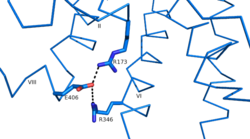Introduction
The
human glucagon receptor (
GCGR) is one of 15 secretin-like, or Class B,
G-protein coupled receptors (GPCRs). Like other GPCRs, it has a helical domain (shown in blue) and a globular N-terminus (shown in magenta). As its name suggests, the 7tm is made up of
alpha helices that pass through the membrane seven times. The extracellular domain has an α-β-β structure that consists of two antiparallel
β-sheets and a N-terminal α-helix
[1].
Function
The glucagon receptor plays an important role in glucose homeostasis. During times of fasting (or low blood sugar) the pancreas dispatches glucagon to activate the GCGR in the liver. The binding of glucagon stimulates gluconeogenesis, through adenylate cyclase that initiates protein kinase A (PKA) activity[2]. This pathway synthesizes glucose, elevating blood sugar levels.
Structure
Class B vs. Class A
In contrast to class A glucagon receptors which have a proline kink, in all secretin-like class B glucagon receptors there is a Glycine at position 393 in Helix VII which allows for a . This glycine helical bend is fully conserved in all secretin-like class B receptors and is an important part of the FQGxxVxxYCF motif.
Another important structural component found in all secretin-like class B receptors are the two conserved
salt bridges found between
Arg 346 and
Glu 406 and Arg 173 and Glu 406
. These salt bridges are a distinct feature of class B receptors only because their interaction results in the distinct stalk found only in class B receptors
[3].
A conserved disulfide bond can be found in 7tm region at which helps to stabilize the 7tm fold. This bond is conserved among both class A and class B receptors. Additionally, the ECD region of Class B GCPRs is defined by three conserved disulfide bonds. These bonds occur at , , and .
As a part of the interface between helices VI, V, and III, a Class B-specific hydrogen bond occurs between Asn 318 of Helix V and Leu 242 of Helix III.
GCGR-Specific Traits
Helix I Stalk Region
The tip of Helix I extends above the cell membrane into the extracellular space creating a . This region is longer than any other class of GPCR and extends 3 α-helical turns above the plane of the membrane. It helps to capture the glucagon peptide and facilitates it's insertion into the 7tm[3].
Intracellular Helix VIII
The GCGR also contains an intracellular Helix VIII that is comprised of roughly 20 amino acids at the C-terminal end. This helix tilts approximately 25 degrees away from the membrane - the corresponding position in class A receptors are turned toward the membrane[3]. Although researchers are not entirely sure of its function, this helix is completely conserved in class B structures.
Binding Pocket
The class B GPCR has the widest and longest binding pocket. The distance between the EC tips of Helicies II and VI as well as between the tips of Helicies III and VII are some of the largest among the GPCRs[3]. As a result, the binding cavity of GCGR is located deeper inside the molecule.
Other Unique Structural Features
An important interface stabilization interaction between Helices I and VII occurs between Ser 152 of Helix I and Ser 390 of Helix VII. Due to their close proximity to one another, they form an important which stabilizes the structure of GCGR.
Glucagon Binding
Research has shown that class B GCPRs exist in either an open or closed conformation. To transition between states, the ECD rotates and moves down towards the 7tm domain. The stalk region of Helix I helps to facilitate this motion of the ECD.
In its open state, the ECD and the stalk region of Helix 1 are almost perpendicular to the membrane surface. In the case of GCGR, this open confirmation is stabilized by glucagon binding. In the absence of glucagon, however, the GCGR adopts a closed conformation in which all three of the extracellular loops of the 7tm (ECL1, ECL2, and ECL3) can interact with the ECD. In this closed state, the ECD covers the extracellular surface of the 7tm.
This transition mechanism is consistent with the "two-domain" binding mechanism of class B GCPRs in which (1) the C-terminus of the ligand first binds to the ECD allowing (2) the N-terminus of the ligand to interact with the 7tm and activate the protein.
Clinical Relevance
Because of GCGR's role in glucose homeostasis, it is a potential drug target for Type 2 diabetes. Specifically, molecules that antagonize the glucagon receptor may be able to lower blood sugar levels. Studies have shown that two antibodies, mAb1 and mAb23, target the ECD domain of the GCGR interrupting glucagon binding[4]. By disrupting the normal interactions between the ECD and the 7tm domains, these antibiotics inhibit the receptor's function and help to lower blood glucose level. Additional research has shown that another antibody, mAb7, inhibits GCGR allosterically[5]. Through binding to a site outside of the binding pocket, mAb7 inhibits the receptor without interacting with essential glucagon binding residues.

